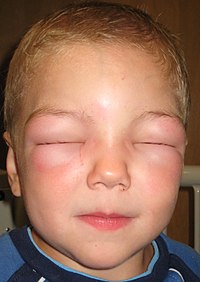
Photo from wikipedia
Abstract Background In hereditary angioedema (HAE), low levels (type 1) or defect in function (type 2) of the serine‐protease inhibitor C1 Inhibitor protein results in activation of the classical pathway… Click to show full abstract
Abstract Background In hereditary angioedema (HAE), low levels (type 1) or defect in function (type 2) of the serine‐protease inhibitor C1 Inhibitor protein results in activation of the classical pathway of the complement system as well as the contact system. Here, we investigated the risk of comorbidities in HAE. Methods Individuals with HAE (n = 239; identified through a physician made diagnosis) and a control cohort from the general population (n = 2383; matched for age, gender, and county of residence) were compared with the Swedish inpatient, cause of death, cancer, and prescription registers. Conditional logistic regression was used to analyze the data. Results Increased risk of cardiovascular disease (odds ratio [OR] 1.83; 95% confidence interval [CI] 1.32–2.54), including arterial (OR 6.74; 95% CI 1.89–24.06) and venous thromboembolic disease (OR 4.20; 95% CI 2.42–7.23) as well as hypertension (OR 1.64; 95% CI 1.12–2.39) was seen in HAE. There was also an increased number of individuals diagnosed with hyperlipidemia (OR 2.01; 95% CI 1.16–3.50) among HAE patients. Furthermore, the risk of autoimmune disease was increased (OR 1.65; 95% CI 1.15–2.35) being particularly pronounced for systemic lupus erythematosus (OR 71.87; 95% CI 8.80–586.7). The risk of having two or more autoimmune diseases was also higher among HAE patients (p = 0.017). In contrast, the risk of cancer was not increased. Data from the prescription register revealed higher prescription rates of drugs against hypertension, hypothyroidism, and hyperlipidemia among HAE patients. Conclusions The results warrant for awareness and prevention of comorbid conditions, in particular, thromboembolic and autoimmune diseases in HAE. Future prophylactic interventions may modify these risks.
Journal Title: Clinical and Translational Allergy
Year Published: 2022
Link to full text (if available)
Share on Social Media: Sign Up to like & get
recommendations!